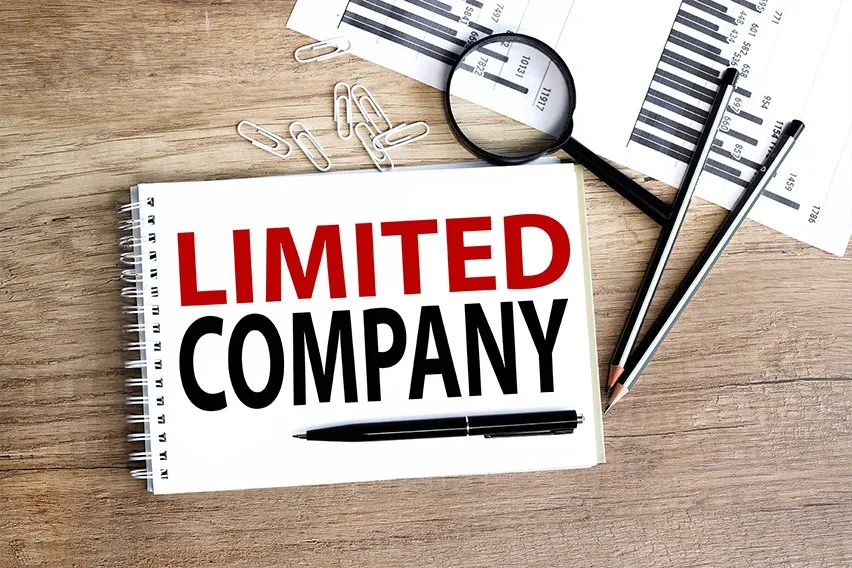What Is a Limited Company and How to Set One Up in the UK

If you’re running a successful business as a self-employed sole trader or partnership, you may be wondering about becoming a limited company.
Even just the briefest skim through HMRC’s guidance shows that it’s not the most straightforward process. Which, let’s face it, is off-putting.
But there are benefits to becoming a limited company that might be perfect for your business.
Find out exactly what being a limited company means, the different business structures you can have, the pros and cons of becoming a limited company and a brief rundown of what you have to do to get started.
It’s important to consider all the funding and tax implications in the context of your business. Then you can decide which is the best option for you
Here’s What We’ll Cover:
Definition of a Limited Company
Different Types of Limited Companies
How to Set Up a Limited Company
Pros and Cons of Becoming a Limited Company
Definition of a Limited Company
Limited liability companies are businesses with a separate legal entity to that of its shareholders, owner and management. Even if you are the only shareholder, owner and manager, the business – now company – is separate from you.
Crucially, this means a distinction between your personal assets and those of the company. This is where the concept of ‘limited’ comes in. Your liability for the debt of the company is limited by its new legal status as an individual financial entity. Lots of sole traders, business partnerships and freelancers find this a very appealing prospect.
It means that whatever is earned by the company belongs to the company. Shareholders and directors can’t just take money out of the company bank account.

In the event of a company being sued, limited company status protects its directors and shareholders from having to use their personal assets to rectify the situation. Unless there is personal criminal action on their part – then there are individual legal consequences. Otherwise there is no personal liability for the company.
As a limited company you have to initially register with Companies House and file an annual Confirmation Statement alongside your accounts with them. These are publicly available.
You also start to pay Corporation Tax, which means keeping accurate records and filing a Corporation Tax return with HMRC every year. Each individual director is also required to file a self assessment tax return with HMRC to pay their individual income tax and National Insurance Contributions.
Different Types of Limited Companies
There are two broad categories of corporate structures:
- Limited by guarantee – these are usually not-for-profit organisations
- Limited by shares – these are businesses that strive to make a profit
These are HMRC’s 4 defining features of a company that’s limited by shares:
- “is legally separate from the people who run it
- has separate finances from your personal ones
- has shares and shareholders
- can keep any profits it makes after paying tax”
We’re going to focus on the latter, as most of our clients are in business. This is now broken down into 3 different business structures: Private limited companies (Ltd), public limited companies (plc) and Limited liability partnerships (LLP)
Private Limited Company
Becoming a private limited company is the simpler of the limited by shares set ups. You only need one shareholder and one director to form private companies, so this is the perfect business entity for a sole trader. And there’s no minimum amount of share capital.
Public Limited Companies
This is the best option for larger companies, as you need a minimum of £50,000 in share capital. In a public company there is also a requirement for a minimum of two shareholders, two directors and a qualified company secretary.
Limited Liability Partnership
In limited partnerships, the company has partners rather than shareholders. They are ‘members’ who own and run the company simultaneously. And they are all equally responsible for the business, including its debts. In this case, unlike other limited company structures, the partners have a hands-on management role.
How to Set Up a Limited Company
If you decide that becoming a limited company is the right thing for your business, there are several important steps to follow.
Choosing a Name
You need to decide on your company name before you apply to Companies House. There are rules about the business names that will be registered. As you would expect, names containing abusive language or expletives won’t be accepted.
But you must also avoid any names that are ‘same as’, or ‘too like’ existing companies. And you need to have ‘limited’ or ‘ltd’ at the end.
There are also some words and phrases that are legally protected and you can only use them with permission from the relevant government department or organisation.
To make all this easier, Companies House has a free online tool called a Company Name Availability Checker.
You can also make sure that you’re not naming your company something that’s already been trademarked by someone else, using the online search tool provided by the Intellectual Property Office.
Choose Your People
You need at least 1 director for your board of directors and 1 shareholder to form a limited company. This can be 1 person – you! Each role comes with a specific set of responsibilities, which are clearly detailed by HMRC here. But they start with the basics of your name and registered UK business address that will then be on the public register.
You also need to identify any People with Significant Control as part of your filing requirement.
Get the Registration Paperwork Ready
As part of your registration with Companies House, you need two important documents. A ‘memorandum of association’, which is “a legal statement signed by all initial shareholders or guarantors agreeing to form the company.” And your ‘articles of association’, which are the “written rules about running the company agreed by the shareholders or guarantors, directors and the company secretary.”
This isn’t quite as bad as it sounds, with all the latin legalese in the titles. There is an online and printable memorandum of association template. And most companies use the ‘standard articles’ to make sure they tick all the right boxes.
Prepare the Future Paperwork
You’re entering a new system when you incorporate your business, so you’re probably expecting a new layer of paperwork. It’s all legally mandatory.
You’ll need to have specific company records, accounting records and produce your accounts and Company Tax Return. This sounds like an enormous administrative burden, but you’ve got your information right there in your FreshBooks account – you’re not doing this alone, even if you’re wearing all the hats in your new limited company!

Register with Companies House
Follow their procedure to the letter and this is a logical process. You need a lot of information to hand, so give yourself enough time to work through it all. Then you need to register for Corporation Tax with HMRC.
Pros and Cons of Becoming a Limited Company
Most business owners decide to incorporate their businesses because of the perceived tax benefits. Your company, as it’s own business entity, pays Corporation Tax on its profits. This is currently 19%. Depending on your taxable income as a sole trader, this may well be a good tax saving. But bear in mind that you still need to pay income tax and National Insurance Contributions on your earnings too.
And there’s more than just tax to think about. It’s very wise to talk this through with your accountant before making any final decisions. Just to be certain that being a limited company is the best option for you.
For more details about different business structures in the UK, have a look at ‘FreshBooks’ 4 Essentials for Starting a Small Business in the UK’.
And for more details about becoming incorporated, see our ‘How to Start a Limited Company in the UK’ guide.
RELATED ARTICLES

 Return on Capital Employed (ROCE): Definition and Calculation
Return on Capital Employed (ROCE): Definition and Calculation What Is Impairment in Accounting?
What Is Impairment in Accounting? Net Present Value (NPV): Definition, Examples & Calculation
Net Present Value (NPV): Definition, Examples & Calculation 6 Free Bookkeeping Courses with Certificates (2025 Edition)
6 Free Bookkeeping Courses with Certificates (2025 Edition)